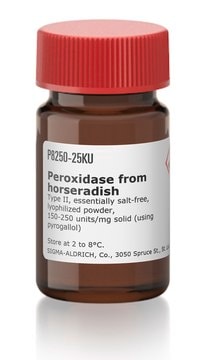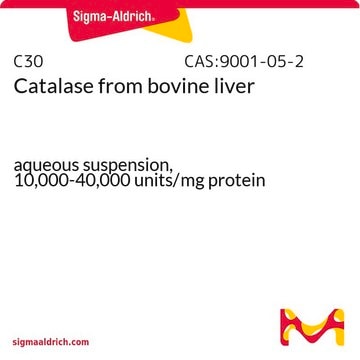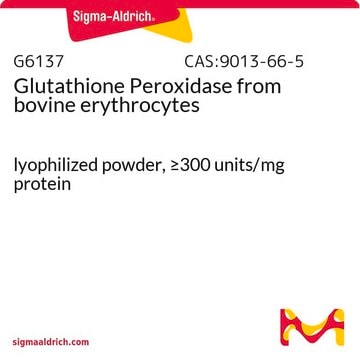S8409
Superoxide Dismutase from bovine liver
ammonium sulfate suspension, 2,000-6,000 units/mg protein (biuret)
Synonym(s):
SOD, Superoxide: superoxide oxidoreductase
About This Item
Recommended Products
form
ammonium sulfate suspension
specific activity
2,000-6,000 units/mg protein (biuret)
mol wt
32.5 kDa
UniProt accession no.
storage temp.
2-8°C
Gene Information
cow ... SOD1(281495)
Looking for similar products? Visit Product Comparison Guide
General description
Superoxide dismutases are a group of low molecular weight metalloproteins present in all aerobic cells of plants, animals, and micro-organisms. They provide protection against damaging reactions with the superoxide radical anion (O2-) by catalyzing its disproportionation into oxygen and hydrogen peroxide.
Application
- for measuring mitochondrial hydrogen peroxide production in skeletal muscle
- as a positive control in Cu(II) binding stability assay
- as a positive control in superoxide dismutase assay
- in a study to assess the inactivation of endothelial-derived relaxing factor by oxidized lipoproteins.
- in a study to investigate the role of hydrogen peroxide in the cytotoxicity of the xanthine/xanthine oxidase system.
Biochem/physiol Actions
Unit Definition
Physical form
Analysis Note
Signal Word
Danger
Hazard Statements
Precautionary Statements
Hazard Classifications
Resp. Sens. 1
Storage Class Code
10 - Combustible liquids
WGK
WGK 1
Flash Point(F)
Not applicable
Flash Point(C)
Not applicable
Personal Protective Equipment
Certificates of Analysis (COA)
Search for Certificates of Analysis (COA) by entering the products Lot/Batch Number. Lot and Batch Numbers can be found on a product’s label following the words ‘Lot’ or ‘Batch’.
Already Own This Product?
Find documentation for the products that you have recently purchased in the Document Library.
Customers Also Viewed
Articles
Instructions for working with enzymes supplied as ammonium sulfate suspensions
Protocols
Enzymatic Assay of Superoxide Dismutase
Separation of Superoxide dismutase
Chromatograms
application for HPLCOur team of scientists has experience in all areas of research including Life Science, Material Science, Chemical Synthesis, Chromatography, Analytical and many others.
Contact Technical Service














